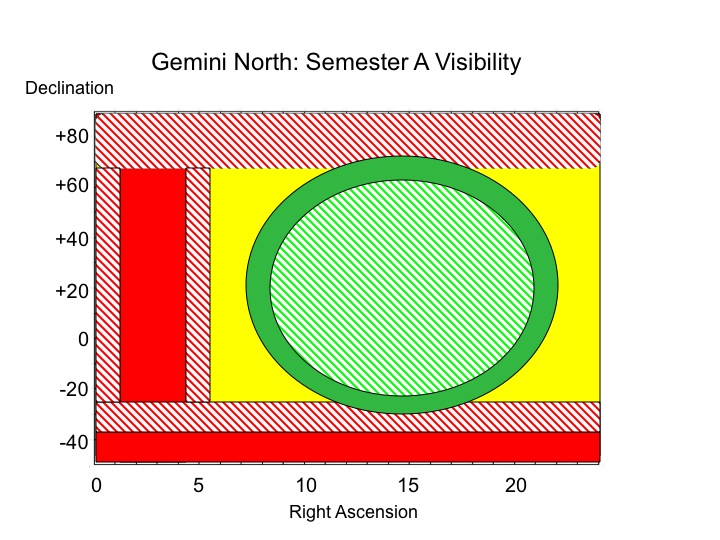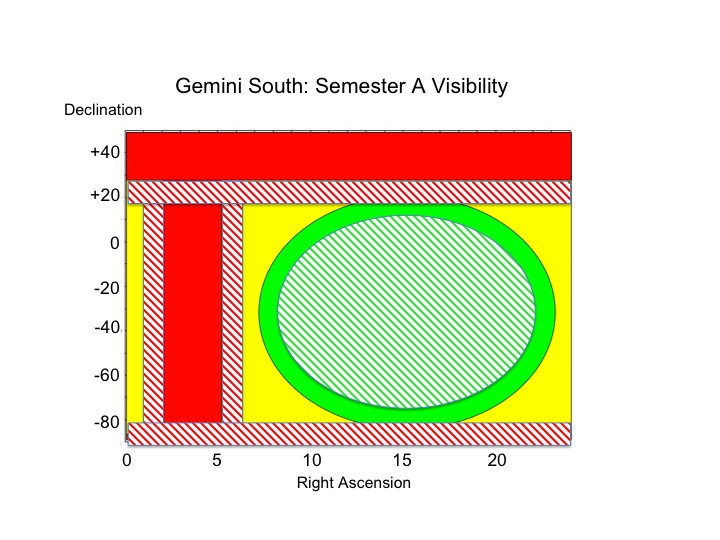This page provides best estimates, at the time of the Call for Proposals, of instrument availability and target (RA, dec) restrictions for 2017A.
Jump to:
- Instrument and Instrument Configuration Restrictions
- Non-Sidereal Targets
- Time Critical Observations
- Gemini North
- Gemini South
- Graphical Illustration
Instrument and Instrument Configuration Restrictions
At each Gemini telescope, instruments are mounted at the Cassegrain focus on the instrument support structure (ISS). A science fold mirror mounted inside the ISS can be rotated to send the light from the telescope to any of four side-looking ports, or can be retracted so that the light goes to the up-looking port. At each site, the calibration unit and the Adaptive Optics system use two of the side ports, leaving two side-looking and one up-looking port for other instrumentation. As more than three instruments are offered each semester, instrument swaps will be required and not all instruments will be available for the entire semester. Instrument swaps will be driven by demand and scheduled to minimize impact on the queue. Certain targets or entire programs may not be feasible once the final schedule is determined, at ITAC or thereafter. If an instrument is requested for less than 6% of the Bands 1+2 time, the Observatory reserves the right to limit the RA range available to programs, or to not schedule the instrument. Changes to the instrument mounting are not permitted during classical runs.
Non-Sidereal Targets
Non-sidereal targets can have a broader range in RA than indicated in the Tables below due to, for example, the need to observe comets relatively close to the Sun. The ephemeris for any submitted target however must include a position that is accessible between evening and morning twilight at some point in the semester. For rapidly moving targets PIs should specify in the proposal when the target is accessible, and the coordinates of the target at that time, so that the observation can be checked for feasibility.
Time-Critical Observations
Gemini Observatory attempts to schedule all time-critical observations whenever possible within the constraints imposed by instrument availability, instrument configuration, weather, and science ranking band. Additionally, nights not scheduled for multi-instrument queue including classical and other observing modes, fast-turnaround blocks, shutdowns, commissioning, etc., impose additional constraints on time-critical programs. Short observations (~1 hour) can often be accommodated during fast-turnaround and priority observing periods. Programs with time-critical observations are encouraged to include detailed scheduling constraints with their proposal, such that they can be considered along with other constraints when developing the telescope schedule each semester.
Gemini North Instrument Availability and Target Accessibility
All instruments are restricted for sky visibility as described in the Table below. In addition:
- Gemini North will not be available from Monday July 10 2017 to the end of the semester (20 days), for work on the dome, reducing the accepted RA range to 4h to 23.5h.
- Gemini North will have dome shutter restrictions in place through 2017A. Gemini North PIs with targets with declinations below -35° and above +78° should have alternative targets available.
- DSSI Speckle Camera will be available, subject to demand, in the first half of 2017A semester; targets are therefore limited to RA 4h to 20h.
- TEXES will be available, subject to demand, in February 2017; targets are therefore limited to RA to 4h to 20h.
- The Laser Guide Star (LGS) system must be used at or above 40 degrees elevation. How this translates into RA and DEC restrictions is indicated in the Table below.
- GMOS-N is not available February 1 through March 19 2017 for Hamamatsu CCDs installation and commissioning. PIs of GMOS-N proposals with targets RA 4h - 9h should have alternative targets available.
| Accessible | Restricted** | Inaccessible | |
| Declination, non-LGS |
-30° to +73° | -37° to -30°, +73° to +90° |
< -37° |
| Declination, LGS |
-25° to +65° | -30° to -25°, +65° to +70° |
< -30° and > +70° |
| Right Ascension, non-LGS |
7h to 22h | 4h to 7h, 22h to 23.5h |
0h to 4h, 23.5h to 0h |
| Right Ascension, LGS |
8h to 21h | 5h to 8h, 21h to 22.5h |
0h to 5h, 22.5h to 0h |
| Right Ascension, TEXES |
6h to 18h | 4h to 6h, 18h to 20h |
0h to 4h, 20h to 0h |
| Right Ascension, DSSI |
6h to 18h | 4h to 6h, 18h to 20h |
0h to 4h, 20h to 0h |
**Due to limited sky availability during the semester, GMOS MOS programs requiring pre-imaging should not have targets in this region, and other programs with targets in this region should not require a large amount of time, or have strict timing or observing constraints.
Gemini South Instrument Availability and Target Accessibility
All instruments are restricted for sky visibility as described in the Table and Figure below. In addition:
- Observations using GeMS are restricted to ≥ 45° elevation. How this translates into RA and DEC restrictions is indicated in the Table.
- GSAOI observations will likely be limited to two scheduled blocks in 2017A (in March and May bright periods). The scheduling and final number of blocks will take into account the demand from the community.
- DSSI will be available, subject to demand, in the second half of the 2017A semester; targets are therefore limited to RA 12h to 1h.
- Phoenix will be available, subject to demand, in the second half of the 2017A semester; targets are therefore limited to RA 12h to 1h.
| Accessible | Restricted** | Inaccessible | |
| Declination | -87° to +22° | -90° to -87°, +22° to +28° |
> +28° |
| Declination, GSAOI + GeMS |
-70° to +10° | -75° to -70°, +10° to +15° |
< -75° and > +15° |
| Declination, GPI |
-75° to +15° | -80° to -75°, +15° to +20° |
< -80° and > +20° |
| Right Ascension | 7h to 23h | 5h to 7h, 23h to 2h |
2h to 5h |
| Right Ascension, GSAOI + GeMS |
8h to 21h | 6h to 8h, 21h to 22h |
21h to 6h |
| Right Ascension, DSSI, Phoenix |
13h to 23h | 12h to 13h, 23h to 1h |
1h to 12h |
**Due to limited sky availability during the semester, GMOS MOS programs requiring pre-imaging should not have targets in this region, and other programs with targets in this region should not require a large amount of time, or have strict timing or observing constraints.
Graphical Illustration

Figure 1: Schematic representation of target accessibility at Gemini North during semester 2017A. Green regions offer unrestricted access, red regions are inaccessible. Hatched areas indicate the more restricted LGS regions. The yellow region is possible, but restricted. See text, and values in the Gemini North Table above.

Figure 2: Schematic representation of target accessibility at Gemini South during semester 2017A. Green regions offer unrestricted access, red regions are inaccessible. Hatched areas indicate the more restricted GeMS regions. The yellow region is possible, but restricted. See text, and values in the Gemini South Table above.
